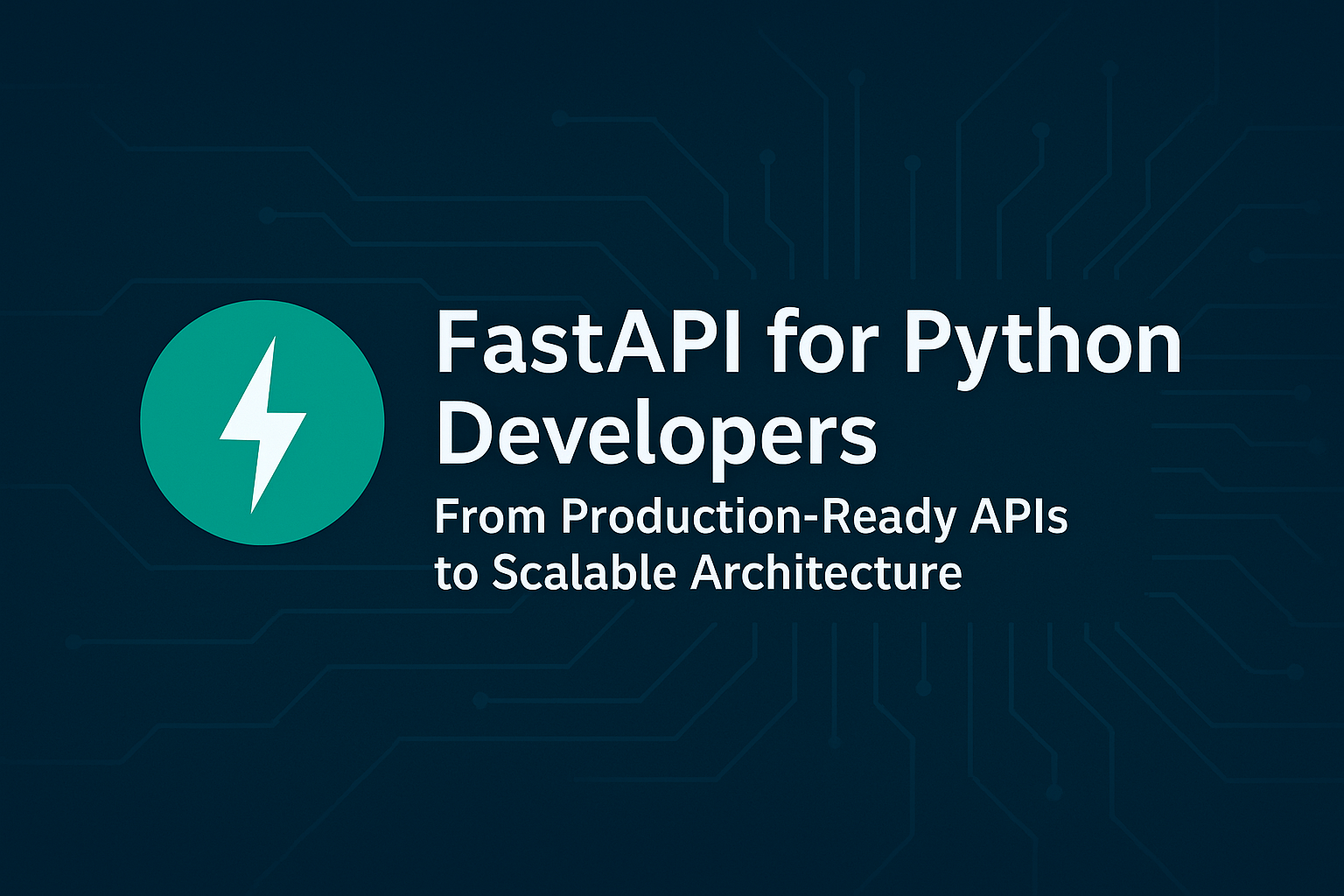FastAPI for Python Developers. From Production-Ready APIs to Scalable Architecture
Who is this course for? This course is designed for Python developers who already know Python syntax, understand the basics of classes, functions, and modules, and have experience building small or medium apps. If you have worked with Flask or …
Overview
Who is this course for?
This course is designed for Python developers who already know Python syntax, understand the basics of classes, functions, and modules, and have experience building small or medium apps. If you have worked with Flask or Django and want to transition to a more modern, async-ready, and high-performance framework, this course will show you how to build robust, production-ready APIs and services using FastAPI. Whether you’re looking to quickly prototype new ideas, deliver scalable microservices, or modernize legacy backends, this course will take you beyond the basics.
What will you learn?
- Core FastAPI Concepts: Understand what makes FastAPI different and why it’s rapidly becoming the go-to Python API framework. Learn async programming basics and how FastAPI leverages Python’s type annotations for automatic validation and docs.
- Project Setup & First Steps: Install FastAPI, scaffold projects, and launch your first endpoints using uvicorn.
- Routing & Parameters: Build RESTful APIs with clear route decorators. Work with path, query, body, header, and cookie parameters, and master type annotations for reliable validation.
- Pydantic Models: Use Pydantic for input/output validation, nested models, field aliases, and custom validators.
- Responses & Status Codes: Return custom responses, set status codes, and manage headers for robust API design.
- Security & Authentication: Secure your APIs with dependency injection, OAuth2, JWT tokens, password hashing, and role-based access control. Protect against CORS and CSRF.
- Database Integration: Connect to SQL and NoSQL databases (SQLAlchemy, SQLModel, Tortoise, Gino, and MongoDB). Perform migrations, handle transactions, and implement CRUD best practices.
- Project Architecture: Organize code with routers, service layers, DI patterns, environment-based configuration, logging, exception handling, and custom middleware.
- Documentation: Leverage FastAPI’s auto-generated docs (Swagger, Redoc), customize OpenAPI schemas, and document endpoints clearly.
- Testing & Debugging: Write robust async tests with pytest and httpx, mock dependencies, and measure test coverage for confidence in your code.
- File Uploads & Media: Handle file uploads, process forms, and return files securely to clients.
- External APIs & Background Tasks: Make async API calls, run background jobs, and use Celery with Redis for scalable task queues.
- Production & Deployment: Deploy FastAPI with Uvicorn, Gunicorn, and Nginx. Containerize with Docker and deploy to Heroku, Railway, Fly.io, or VPS. Configure HTTPS and reverse proxying.
- Advanced Topics: Integrate WebSockets, GraphQL, gRPC, SSE, and event-driven architecture with Kafka.
How will this help you?
After completing this course, you’ll be able to:
- Build scalable, async-ready REST APIs and services.
- Integrate robust authentication and security features.
- Work with both SQL and NoSQL databases efficiently.
- Structure production-grade FastAPI projects for maintainability and growth.
- Document, test, and deploy your APIs with confidence.
- Handle real-world challenges like file uploads, background tasks, and third-party integrations.
- Leverage advanced FastAPI patterns for modern, distributed systems.
Why FastAPI?
FastAPI is rapidly growing in popularity for its speed, intuitive code, and automatic documentation. Its async-first approach and tight integration with Python typing and Pydantic make it ideal for high-performance, maintainable web backends. Whether you’re building microservices, data APIs, or modern SaaS platforms, FastAPI gives you the tools to succeed.
By the end of this course, you’ll be ready to architect, secure, and scale FastAPI applications in real production environments.
Curriculum
- 12 Sections
- 52 Lessons
- Lifetime
- 1. Core FastAPI Concepts and Setup9
- 1.1KHK6 1.1 What is FastAPI? Differences from Flask/Django
- 1.2KHK6 1.2 Async and await in FastAPI
- 1.3KHK6 1.3 Installing FastAPI and project scaffolding
- 1.4KHK6 1.4 Your first endpoint and running with uvicorn
- 1.5KHK6 1.5 Route decorators: @app.get, @app.post, etc.
- 1.6KHK6 1.6 Using Path, Query, Body, Header, Cookie parameters
- 1.7KHK6 1.7 Type annotations and automatic validation
- 1.8KHK6 1.8 Custom responses and status codes
- 1.9KHK6 1. Quiz3 Questions
- 2. Working with Pydantic Models4
- 3. Security and Authentication8
- 3.1KHK6 3.1 Dependency injection with Depends
- 3.2KHK6 3.2 OAuth2 and JWT authentication
- 3.3KHK6 3.3 OAuth2 Password Flow
- 3.4KHK6 3.4 Building custom dependencies
- 3.5KHK6 3.5 Role-based access control (RBAC)
- 3.6KHK6 3.6 Password hashing and secure storage
- 3.7KHK6 3.7 CORS and CSRF protection
- 3.8KHK6 3. Quiz3 Questions
- 4. Database Integration7
- 4.1KHK6 4.1 Connecting to databases with SQLAlchemy
- 4.2KHK6 4.2 Using async ORMs: SQLModel, Tortoise ORM, Gino
- 4.3KHK6 4.3 Database migrations with Alembic
- 4.4KHK6 4.4 Handling transactions and rollbacks
- 4.5KHK6 4.5 Implementing CRUD operations
- 4.6KHK6 4.6 Working with MongoDB and motor
- 4.7KHK6 4. Quiz3 Questions
- 5. Project Architecture and Middleware7
- 5.1KHK6 5.1 Modularizing with routers and services
- 5.2KHK6 5.2 Service layer and DI patterns
- 5.3KHK6 5.3 Configuration management with .env and Pydantic Settings
- 5.4KHK6 5.4 Logging with logging and loguru
- 5.5KHK6 5.5 Custom exception handling
- 5.6KHK6 5.6 Using custom middlewares
- 5.7KHK6 5. Quiz3 Questions
- 6. Documentation and Serialization4
- 7. Testing and Debugging5
- 8. File Uploads, Forms, and Media4
- 9. External APIs and Background Tasks4
- 10. Production and Deployment5
- 11. Advanced Topics6
- KHK6 FinalQuiz1








